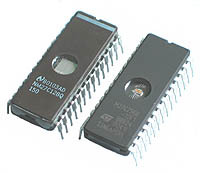-
Erase Prom With Uv Light카테고리 없음 2020. 1. 23. 21:35

Click to expand.UV LEDs produce nearly enough nothing at wavelengths much below 350 nm.There is a 350 nm model with extremely low output power, and otherwiseUV LEDs have peak wavelength 365 nm and up. All easily available ones atany reasonable price have a peak wavelength 370-375 nm or more. Spectralcontent falls rapidly at wavelengths shorter than the peak wavelength.The usual lamps used to erase EPROMs and kill bacteria do that with 254nm. I have heard of sunlight erasing EPROMS over several days or a coupleweeks in Arizona, and I would guess wavelengths near the shortest gettingthrough the atmosphere in any amount (around or possibly slightly over 300nm) are responsible. I doubt Arizona sunlight sterilizes toothbrushes,although a car parked in the sun on a bad day in Phoenix can get hotenough to kill a lot of bacteria.- Don Klipstein. UV LEDs produce nearly enough nothing at wavelengths much below 350 nm.There is a 350 nm model with extremely low output power, and otherwiseUV LEDs have peak wavelength 365 nm and up.
1 x UV EPROM Eraser. Used to erase the storage chip of EPROM. UV light: 1-60 minutes. Can erase all the data in 10 minutes. The programming process is not electrically reversible. To erase the data stored in the array of transistors, ultraviolet light is directed onto the die. Photons of the UV light cause ionization within the silicon oxide, which allow the stored charge on the floating gate to dissipate.


All easily available ones atany reasonable price have a peak wavelength 370-375 nm or more. Spectralcontent falls rapidly at wavelengths shorter than the peak wavelength.The usual lamps used to erase EPROMs and kill bacteria do that with 254nm. I have heard of sunlight erasing EPROMS over several days or a coupleweeks in Arizona, and I would guess wavelengths near the shortest gettingthrough the atmosphere in any amount (around or possibly slightly over 300nm) are responsible.
Eprom Vs Eeprom

I doubt Arizona sunlight sterilizes toothbrushes,although a car parked in the sun on a bad day in Phoenix can get hotenough to kill a lot of bacteria. Click to expand.That is a pretty good correlation to 'several days or a couple of weeks'.In terms of useability, the first failure was what mattered. In the UK (alot less Sun.), I have known a couple of test chips fail after about sixmonths, in equipment with no attempt to block light. Even when erasing theEEPROM, in a proper eraser, it is very noticeable that some cells, seem totake vastly longer than others. Unless the unit was 'tracking' the Sun,presumably some cells were getting a lot more exposure than others nearthe shaded edge, and these would take a long time to clear.I doubt if a UV LED, could erase an EPROM in any reasonable time. Thelight from these LED's, generally has more in common wth the longerwavelengths given by UV flouresescent tubes, than the lamps used inerasers.Best Wishes. That is a pretty good correlation to 'several days or a couple of weeks'.In terms of useability, the first failure was what mattered.
In the UK (alot less Sun.), I have known a couple of test chips fail after about sixmonths, in equipment with no attempt to block light. Even when erasing theEEPROM, in a proper eraser, it is very noticeable that some cells, seem totake vastly longer than others. Unless the unit was 'tracking' the Sun,presumably some cells were getting a lot more exposure than others nearthe shaded edge, and these would take a long time to clear.I doubt if a UV LED, could erase an EPROM in any reasonable time. Thelight from these LED's, generally has more in common wth the longerwavelengths given by UV flouresescent tubes, than the lamps used inerasers.Best Wishes. Click to expand.410 nm is visible.Many LEDs with peak wavelength 405 +/- 5 nm are a little common andmarketed as 'UV', although 405 nm has been considered visible before theseLEDs appeared on the market.LEDs with peak wavelength 395 +/- 5 nm are common, and that wavelengthis visible enough to give these LEDs a violet glow.
The longer wavelengthportion of the spectral band of these is in the 'officially' visiblerange.LEDs with peak wavelength 375 nm have the longwave 'tail' of theiremission band with enough content at wavelengths visible enough to makethem glow visibly violet. But with those, most of the visible spectralcontent is broadband and spurious emissions, so these appear violetishwhite and dimmer than the 395 nm ones.- Don Klipstein.
